Sukhoi Su-27
| Su-27 | |
|---|---|
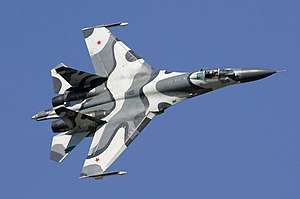 | |
| Su-27SKM at MAKS-2005 airshow | |
| Role | Multirole fighter, air superiority fighter |
| National origin | Soviet Union / Russia |
| Manufacturer | Sukhoi |
| First flight | 20 May 1977 |
| Introduction | 22 June 1985 |
| Status | In service |
| Primary users | Russian Air Force People's Liberation Army Air Force Ukrainian Air Force See Operators section for others |
| Produced | 1982–present |
| Number built | 809 |
| Unit cost |
US$30 million |
| Variants | Sukhoi Su-30 Sukhoi Su-33 Sukhoi Su-34 Sukhoi Su-35 Sukhoi Su-37 Shenyang J-11 |
The Sukhoi Su-27 (Russian: Сухой Су-27; NATO reporting name: Flanker) is a twin-engine supermaneuverable fighter aircraft designed by Sukhoi. It was intended as a direct competitor for the large United States fourth-generation fighters such as the Grumman F-14 Tomcat and F-15 Eagle, with 3,530-kilometre (1,910 nmi) range, heavy aircraft ordnance, sophisticated avionics and high maneuverability. The Su-27 was designed for air superiority missions, and subsequent variants are able to perform almost all aerial warfare operations. It was designed with the Mikoyan MiG-29 as its complement.
The Su-27 entered service with the Soviet Air Forces in 1985. The primary role was long range air defence against American SAC B-1B and B-52G/H bombers, protecting the Soviet coast from aircraft carriers and flying long range fighter escort for Soviet heavy bombers such as the Tu-95 "Bear", Tu-22M "Backfire" and Tu-160 "Blackjack".[1]
There are several related developments of the Su-27 design. The Su-30 is a two-seat, dual-role fighter for all-weather, air-to-air and air-to-surface deep interdiction missions. The Su-33 'Flanker-D' is a naval fleet defense interceptor for use on aircraft carriers. Further versions include the side-by-side two-seat Su-34 'Fullback' strike/fighter-bomber variant, and the Su-35 'Flanker-E' improved air superiority and multi-role fighter. The Shenyang J-11 is a Chinese licence-built version of the Su-27.
Development
In 1969, the Soviet Union learned of the U.S. Air Force's "F-X" program, which resulted in the F-15 Eagle. The Soviet leadership soon realized that the new American fighter would represent a serious technological advantage over existing Soviet fighters. What was needed was a better-balanced fighter with both good agility and sophisticated systems. In response, the Soviet General Staff issued a requirement for a Perspektivnyy Frontovoy Istrebitel (PFI, literally "Prospective Frontline Fighter", roughly "Advanced Frontline Fighter").[2] Specifications were extremely ambitious, calling for long range, good short-field performance (including the ability to use austere runways), excellent agility, Mach 2+ speed, and heavy armament. The aerodynamic design for the new aircraft was largely carried out by TsAGI in collaboration with the Sukhoi design bureau.[2]
When the specification proved too challenging and costly for a single aircraft in the number needed, the PFI specification was split into two: the LPFI (Lyogkyi PFI, Lightweight PFI) and the TPFI (Tyazholyi PFI, Heavy PFI). The LPFI program resulted in the Mikoyan MiG-29, a relatively short-range tactical fighter, while the TPFI program was assigned to Sukhoi OKB, which eventually produced the Su-27 and its various derivatives.

The Sukhoi design, which was altered progressively to reflect Soviet awareness of the F-15's specifications, emerged as the T-10 (Sukhoi's 10th design), which first flew on 20 May 1977. The aircraft had a large wing, clipped, with two separate podded engines and a twin tail. The ‘tunnel’ between the two engines, as on the F-14 Tomcat, acts both as an additional lifting surface and hides armament from radar.
Air Force
The T-10 was spotted by Western observers and assigned the NATO reporting name 'Flanker-A'. The development of the T-10 was marked by considerable problems, leading to a fatal crash of the second prototype, the T-10-2 on 7 July 1978,[3] due to shortcomings in the FBW control system.[4] Extensive redesigns followed (T-10-3 through T-10-15) and a revised version of the T-10-7, now designated the T-10S, made its first flight on 20 April 1981. It also crashed due to control problems and was replaced by T-10-12 which became T-10S-2. This one also crashed on 23 December 1981 during a high-speed test, killing the pilot.[5][6] Eventually the T-10-15 demonstrator, T-10S-3, evolved into the definitive Su-27 configuration.[7]
The T-10S-3 was modified and officially designated the P-42, setting a number of world records for time-to-height, beating those set in 1975 by a similarly modified F-15 called "The Streak Eagle".[8] The P-42 "Streak Flanker" was stripped of all armament, radar and operational equipment. The fin tips, tail-boom and the wingtip launch rails were also removed. The composite radome was replaced by a lighter metal version. The aircraft was stripped of paint, polished and all drag-producing gaps and joints were sealed. The engines were modified to deliver an increase in thrust of 1,000 kg (2,200 lb), resulting in a thrust-to-weight ratio of almost 2:1 (for comparison with standard example see Specifications).[9][10]
.jpg)
The production Su-27 (sometimes Su-27S, NATO designation 'Flanker-B') began to enter VVS operational service in 1985, although manufacturing difficulties kept it from appearing in strength until 1990.[11] The Su-27 served with both the V-PVO and Frontal Aviation. Operational conversion of units to the type occurred using the Su-27UB (Russian for "Uchebno Boevoy" - "Combat Trainer", NATO designation 'Flanker-C') twin-seat trainer, with the pilots seated in tandem.[12]
When the naval Flanker trainer was being conceived the Soviet Air Force was evaluating a replacement for the Su-24 "Fencer" strike aircraft, and it became evident to Soviet planners at the time that a replacement for the Su-24 would need to be capable of surviving engagements with the new American F-15 and F-16. The Sukhoi bureau concentrated on adaptations of the standard Su-27UB tandem seat trainer. However the Soviet Air Force favoured the crew station (side-by-side seating) approach used in the Su-24 as it worked better for the high workload and potentially long endurance strike roles. Therefore, the conceptual naval side-by-side seated trainer was used as the basis for development of the Su-27IB (Russian for "Istrebityel Bombardirovshchik" - "Fighter Bomber") as an Su-24 replacement in 1983. The first production airframe was flown in early 1994 and renamed the Su-34 (NATO reporting name 'Fullback').[13]
Navy
Development of a version for the Soviet Navy called the Su-27K (Russian for "Korabyelny" - "Shipborne", NATO designation 'Flanker-D') commenced not long after the development of the main land based type. Some of the T10 demonstrators were modified to test features of navalized variants for carrier operations. These modified demonstrators led to specific prototypes for the Soviet Navy, designated "T10K" (Korabyelny). The T10Ks had canards, an arresting hook and carrier landing avionics as well as a retractable inflight re-fueling probe. They did not have the landing gear required for carrier landings or folding wings. The first T10K flew in August 1987 flown by the famous Soviet test pilot Viktor Pugachev (who first demonstrated the cobra manoeuvre using an Su-27 in 1989), performing test take-offs from a land-based ski-jump carrier deck on the Black Sea coast at Saky in the Ukrainian SSR. The aircraft was lost in an accident in 1988.
At the time the naval Flanker was being developed the Soviets were building their first generation of aircraft carriers and had no experience with steam catapults and did not want to delay the introduction of the carriers. Thus it was decided to use a take-off method that did not require catapults by building up full thrust against a blast deflector until the aircraft sheared restraints holding it down to the deck. The fighter would then accelerate up the deck onto a ski jump and become airborne.[14]
The production Su-27K featured the required strengthened landing gear with a two-wheel nose gear assembly, folding stabilators and wings, outer ailerons that extended further with inner double slotted flaps and enlarged leading-edge slats for low-speed carrier approaches, modified LERX (Leading Edge Root eXtension) with canards, a modified ejection seat angle, upgraded FBW, upgraded hydraulics, an arresting hook and retractable in-flight refuelling probe with a pair of deployable floodlights in the nose to illuminate the tanker at night. The Su-27K began carrier trials in November 1989, again with Pugachev at the controls, on board the first Soviet aircraft carrier, called "Tbilisi" at the time and formal carrier operations commenced in September 1991.[15][16]
Development of the naval trainer, called the Su-27KUB (Russian for "Korabyelny Uchebno-Boyevoy" - "Shipborne Trainer-Combat"), began in 1989. The aim was to produce an airframe with dual roles for the Navy and Air Force suitable for a range of other missions such as reconnaissance, aerial refuelling, maritime strike and jamming. This concept then evolved into the Su-27IB (Su-34 "Fullback") for the Soviet Air Force. The naval trainer had a revised forward fuselage to accommodate a side-by-side cockpit seating arrangement with crew access via a ladder in the nose-wheel under carriage and enlarged canards, stabilisers, fins and rudders. The wings had extra ordnance hard-points and the fold position was also moved further outboard. The inlets were fixed and did not feature FOD suppression hardware. The central fuselage was strengthened to accommodate 45 tonnes (99,000 pounds) maximum gross weight and internal volume was increased by 30%. This first prototype, the T-10V-1, flew in April 1990 conducting aerial refuelling trials and simulated carrier landing approaches on the Tbilisi. The second prototype, the T-10V-2 was built in 1993 and had enlarged internal fuel tanks, enlarged spine, lengthened tail and tandem dual wheel main undercarriage.[13]
Export and post-Soviet development
In 1991, the production facilities at Komsomolsk-on-Amur Aircraft Plant and Irkutsk developed export variants of the Su-27: the Su-27SK single seat fighter and Su-27UBK twin-seat trainer, (the K in both variants is Russian for "Kommercheskiy" - literally "Commercial")[17] which have been exported to China, Vietnam, Ethiopia and Indonesia.[18]
After the collapse of the USSR in 1991, Russia, the successor state, started development of advanced variants of the Su-27 including the Su-30, Su-33, Su-34, Su-35, and Su-37.
Since 1998 the export Su-27SK has been produced as the Shenyang J-11 in China under licence. The first licensed-production plane, assembled in Shenyang from Russian supplied kits, was flight tested on 16 December 1998. These licence-built versions, which numbered 100, were designated J-11A. The next model, the J-11B made extensive use of Chinese developed systems within the Su-27SK airframe.[19]
Starting in 2004, the Russian Air Force began a major update of the original Soviet Su-27 ('Flanker-B') fleet. The upgraded variants were designated Su-27SM (Russian for "Seriyniy Modernizovanniy" - literally "Serial Modernized"). This included upgrades in air-to-air capability with the RVV-AE missile with an active radar homing head. The modernized Su-27SM fighters belong to the 4+ generation. The strike capability was enhanced with the addition of the Kh-29T/TE/L and Kh-31P/Kh-31A ASM and KAB-500KR/KAB-1500KR smart bombs. The avionics were also upgraded.[20]
The Su-30 is a two-seat multi-role version developed from the Su-27UBK and was designed for export and evolved into two main variants. The export variant for China, the SU-30MKK ('Flanker-G') which first flew in 1999. The other variant developed as the export version for India, the Su-30MKI ('Flanker-H') was delivered in 2002 and has at least five other configurations.
The Su-33 is the Russian Navy version of the Soviet Su-27K which was re-designated by the Sukhoi Design Bureau after 1991. (Both have the NATO designation 'Flanker-D')
The Su-34 is the Russian derivative of the Soviet-era Su-27IB, which evolved from the Soviet Navy Su-27KUB operational conversion trainer. It was previously referred to as the Su-32MF.
The newest and most advanced version of the Su-27 is the Su-35S ("Serial"). The Su-35 was previously referred to as the Su-27M, Su-27SM2, and Su-35BM.[21]
The Su-37 is an advanced technology demonstrator derived from Su-35 prototypes, featuring thrust vectoring nozzles made of titanium rather than steel and an updated airframe containing a high proportion of carbon-fibre and Al-Li alloy.[22] Only two examples were built and in 2002 one crashed, effectively ending the program. The Su-37 improvements did however make it into new Flanker variants such as the Su-35S and the Su-30MKI.[23]
Design
.jpg)

The Su-27's basic design is aerodynamically similar to the MiG-29, but it is substantially larger. The wing blends into the fuselage at the leading edge extensions and is essentially a cross between a swept wing and a cropped delta (the delta wing with tips cropped for missile rails or ECM pods). The fighter is also an example of a tailed delta wing configuration, retaining conventional horizontal tailplanes.
The Su-27 had the Soviet Union's first operational fly-by-wire control system, based on the Sukhoi OKB's experience with the T-4 bomber project. Combined with relatively low wing loading and powerful basic flight controls, it makes for an exceptionally agile aircraft, controllable even at very low speeds and high angle of attack. In airshows the aircraft has demonstrated its maneuverability with a Cobra (Pugachev’s Cobra) or dynamic deceleration – briefly sustained level flight at a 120° angle of attack.
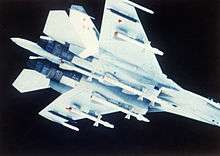
The naval version of the 'Flanker', the Su-27K (or Su-33), incorporates canards for additional lift, reducing takeoff distances. These canards have also been incorporated in some Su-30s, the Su-35, and the Su-37.
The Su-27 is equipped with a Phazotron N001 Myech coherent Pulse-Doppler radar with track while scan and look-down/shoot-down capability. The fighter also has an OLS-27 infrared search and track (IRST) system in the nose just forward of the cockpit with an 80–100 km range.[24]
The Su-27 is armed with a single 30 mm Gryazev-Shipunov GSh-30-1 cannon in the starboard wingroot, and has up to 10 hardpoints for missiles and other weapons. Its standard missile armament for air-to-air combat is a mixture of R-73 (AA-11 Archer) and R-27 (AA-10 'Alamo') missiles, the latter including extended range and infrared homing models.
Operational history
Soviet Union and Russia
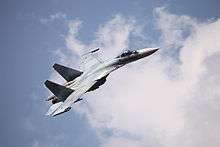
The Soviet Air Force began receiving Su-27s in June 1985. It officially entered service in August 1990.[25]
On 13 September 1987, a fully armed Soviet Su-27, Red 36, intercepted a Norwegian Lockheed P-3 Orion maritime patrol aircraft flying over the Barents Sea. The Soviet fighter jet performed different close passes, colliding with the reconnaissance aircraft on the third pass. The Su-27 disengaged and both aircraft landed safely at their bases.[26]
These aircraft were used by the Russian Air Force during the 1992–1993 war in Abkhazia against Georgian forces. One fighter, piloted by Major Vaclav Alexandrowich Shipko (Вацлав Александрович Шипко) was reported shot down in friendly fire by an S-75M Dvina on 19 March 1993 while intercepting Georgian Su-25s performing close air support. The pilot was killed.[27][28]
In the 2008 South Ossetia War, Russia used Su-27s to gain airspace control over Tskhinvali, the capital city of South Ossetia.[29][30]
On 7 February 2013, two Su-27s briefly entered Japanese airspace off Rishiri Island near Hokkaido, flying south over the Sea of Japan before turning back to the north.[31] Four Mitsubishi F-2 fighters were scrambled to visually confirm the Russian planes,[32] warning them by radio to leave their airspace.[33] A photo taken by a JASDF pilot of one of the two Su-27s was released by the Japan Ministry of Defense.[34] Russia denied the incursion, saying the jets were making routine flights near the disputed Kuril Islands.[31] In another encounter, on 23 April 2014 an Su-27 nearly collided with a United States Air Force Boeing RC-135U over the Sea of Okhotsk.[35]
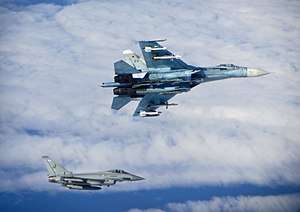
Russia plans to replace the Su-27 and the Mikoyan MiG-29 eventually with the Sukhoi Su-57 stealth fifth-generation multi-role twin-engine fighter.[36]
A squadron of Su-27SM3s was deployed to Syria in November 2015 as part of the Russian military intervention in the Syrian Civil War.[37]
Ethiopia
Ethiopian Su-27s reportedly shot down two Eritrean MiG-29s and damaged another one[38][39] in February 1999 and destroyed another two in May 2000.[39][40] The Su-27s were also used in combat air patrol (CAP) missions, suppression of air defense, and providing escort for fighters on bombing and reconnaissance missions.[41] The Ethiopian Air Force (EtAF) used their Su-27s to deadly effect, bombing Islamist garrisons and patrolling the airspace. The Su-27 has replaced the aging Mikoyan-Gurevich MiG-21, which was the main air superiority fighter of the EtAF between 1977 and 1999.[42]
Angola
The Su-27 entered Angolan service in mid-2000 during the Angolan Civil War. It is reported that one Su-27 in the process of landing, was shot down by 9K34 Strela-3 MANPADs fired by UNITA forces on 19 November 2000.[38][43]
Indonesia
Four Indonesian Flanker-type fighters including Su-27s participated for the first time in the biennial Exercise Pitch Black exercise in Australia on 27 July 2012. Arriving at Darwin, Australia, the two Su-27s and two Sukhoi Su-30s were escorted by two Australian F/A-18 Hornets of No. 77 Squadron, Royal Australian Air Force.[44] Exercise Pitch Black 12 was conducted from 27 July through 17 August 2012, and involved 2,200 personnel and up to 94 aircraft from Australia, Indonesia, Singapore, Thailand, New Zealand and the United States.[45]
Ukraine
.jpg)
During the post-Euromaidan Ukrainian crisis of 2014, a Ukrainian Air Force Su-27 was scrambled to intercept Russian fighter jets over Ukraine's airspace over the Black Sea on 3 March.[46] With no aerial opposition and other aircraft available for ground attack duties, Ukrainian Su-27s played only a small role in the 2014–15 Ukraine conflict. Ukrainian Su-27s were recorded performing low fly passes and were reported flying top cover, combat air patrols and eventual escort or intercept of civil aviation traffic over Eastern Ukraine.[47][48] On 15 April 2014, a video purportedly showing a Ukrainian Su-27 being shot down was released, but the video proved to be a hoax, taken from a previous video of the Syrian Civil War involving a different aircraft model. Videos taken of low-flying Su-27s involved in the operation revealed they were armed with R-27 and R-73 air-to-air missiles.[49]
Variants
Source:[50]
Soviet era
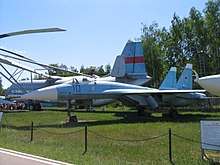

- T10 ("Flanker-A")
- Initial prototype configuration.
- T10S
- Improved prototype configuration, more similar to production spec.
- P-42
- Special version built to beat climb time records. The aircraft had all armament, radar and paint removed, which reduced weight to 14,100 kg. It also had improved engines. Similar to the US F-15 Streak Eagle project.
- Su-27
- Pre-production series built in small numbers with AL-31 engine.
- Su-27S (Su-27 / "Flanker-B")
- Initial production single-seater with improved AL-31F engine. The "T10P".
- Su-27P (Su-27 / "Flanker-B")
- Standard version but without air-to-ground weapons control system and wiring and assigned to Soviet Air Defence Forces units. Often designated Su-27 without -P.[51]
- Su-27UB ("Flanker-C")
- Initial production two-seat operational conversion trainer.
- Su-27SK
- Export Su-27S single-seater. Exported to China in 1992-1996 and developed into Shenyang J-11.
- Su-27UBK
- Export Su-27UB two-seater.
_DD-SD-99-06153.jpg)
- Su-27K (Su-33 / "Flanker-D")
- Carrier-based single-seater with folding wings, high-lift devices, and arresting gear, built in small numbers. They followed the "T10K" prototypes and demonstrators.
- Su-27M (Su-35/Su-37, Flanker-E/F)
- Improved demonstrators for an advanced single-seat multi-role Su-27S derivative. These also included a two-seat "Su-35UB" demonstrator.
- Su-27PU (Su-30)
- Two-seat version of the Su-27P interceptor, designed to support with tactical data other single-seat Su-27P, MiG-31 and other interceptor aircraft in PVO service. Later prototypes renamed Su-30 by Russia, and modified into a multi-role fighter mainly for export market, moving away from the original purpose of the aircraft.
- Su-32 (Su-27IB)
- Two-seat dedicated long-range strike variant with side-by-side seating in "platypus" nose. Prototype of Su-32FN and Su-34 'Fullback'.
Post-Soviet era
- Su-27PD
- Single-seat demonstrator with improvements such as inflight refuelling probe.
- Su-30M / Su-30MK
- Next-generation multi-role two-seater. A few Su-30Ms were built for Russian evaluation in the mid-1990s, though little came of the effort. The Su-30MK export variant was embodied as a series of two demonstrators of different levels of capability. Versions include Su-30MKA for Algeria, Su-30MKI for India, Su-30MKK for the People's Republic of China, and Su-30MKM for Malaysia.
- Shenyang J-11
- Chinese version of Su-27SK.
- Su-27SM (Flanker-B Mod. 1)
- Mid-life upgraded Russian Su-27S, featuring technology evaluated in the Su-27M demonstrators.
- Su-27SKM
- Single-seat multi-role fighter for export. It is a derivative of the Su-27SK but includes upgrades such as advanced cockpit, more sophisticated self-defense electronic countermeasures (ECM) and an in-flight refuelling system.[52]
- Su-27UBM
- Comparable upgraded Su-27UB two-seater.
- Su-27SM2
- 4+ gen block upgrade for Russian Su-27, featuring some technology of the Su-35BM; it includes Irbis-E radar, and upgraded engines and avionics.
- Su-27SM3
- The same as the Su-27SM but is built new rather than a mid-life upgrade.[53]
- Su-27KUB
- Essentially an Su-27K carrier-based twin-seater with a side-by-side cockpit, for use as a naval carrier trainer or multi-role aircraft.
- Su-35BM/Su-35S
- Also named the "Last Flanker" is latest development from Sukhoi Flanker family. It features improved thrust vectoring AL-41F1S engines, new avionics, new radar and reduced radar cross-section.
- Su-27UB1M
- Ukrainian modernized version of the Su-27UB.
- Su-27UP1M
- Ukrainian modernized version of the Su-27UP.
- Su-27S1M
- Ukrainian modernized version of the Su-27S.
- Su-27P1M
- Ukrainian modernized version of the Su-27P.
list of Sukhoi Su-27 derivatives and number of production.
| Aircraft model | Produced | Number built [54] |
|---|---|---|
| Sukhoi Su-27 | 1982–present | 809 |
| Sukhoi Su-33 | 1987–1999 | 35 |
| Sukhoi Su-30 | 1992–present | 612 |
| Sukhoi Su-35 | 2007–present | 82 |
| Sukhoi Su-34 | 2006–present | 116 |
| Sukhoi Su-37 | 2 April 1996 | 1 |
| total variant numbers | 1982–present | 1655 |
Operators
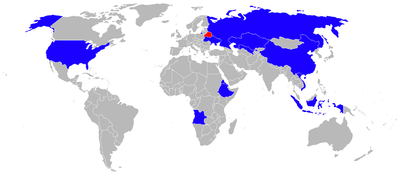

- People's Air and Air Defence Force of Angola – Seven Su-27s in service as of January 2013.[55] Three were bought from Belarus in 1998. Received a total of eight.[56] One was reportedly shot down on 19 November 2000 by a 9K34 Strela-3 MANPADS during the Angolan Civil War.[57]

- People's Liberation Army Air Force (PLAAF) – 59 Su-27 fighters, consisting of 33 Su-27SKs and 26 Su-27UBKs as of January 2013.[55] 78 Flankers were delivered under three separate contracts by the Russian KnAAPO and IAPO plants. Delivery of the aircraft began in February 1991 and finished by September 2009. The first contract was for 20 Su-27SK and 4 Su-27UBK aircraft. The deal, known as '906 Project' within China, saw the Su-27 exported to a foreign country for the first time. In February 1991, an Su-27 performed a flight demonstration at Beijing's Nanyuan Airport. The official induction to service with the PLAAF occurred shortly thereafter. China found some of the delivered Su-27UBKs are "second-handed", consequently Russia delivered 2 more Su-27UBKs to China as a compensation.[58] Chinese Su-27 pilots described its performance as "outstanding" in all aspects and flight envelopes. Differences over the payment method delayed the signing of the second, identical contract. For the first batch, 70% of the payment had been made in barter transactions with light industrial goods and food. Russian Federation argued that future transactions should be made in US dollars. In May 1995, Chinese Central Military Commission Vice Chairman, Liu Huaqing visited Russia and agreed to the term, on a condition that the production line of Su-27 be imported. The contract was signed the same year. Delivery of the final aircraft from the second batch, which consists of 16 Su-27SKs and 8 Su-27UBKs occurred in July 1996. In preparation for the expanding Su-27 fleet, the PLAAF sought to augment its trainer fleet. On 3 December 1999, a third contract was signed, this time for 28 Su-27UBKs. All 76 of the aircraft featured strengthened airframe and landing gear – result of the PLAAF demands that the fighter has a "usable" air-ground capability. As a result, the aircraft are capable of employing most of the conventional Air-to-Ground ordnance produced by Russia. Maximum Take-Off Weight (MTOW) increased to 33,000 kg (72,750 lb). As is common for Russian export fighters, the active jamming device was downgraded; Su-27's L005 ECM pod was replaced with the L203/L204 pod. Furthermore, there were slight avionics differences between the batches. The first batch had N001E radar, while the later aircraft had N001P radar, capable of engaging two targets at the same time. Additionally, ground radar and navigational systems were upgraded. The aircraft are not capable of deploying the R-77 "Adder" missile due to a downgraded fire control system,[59] except for the last batch of 28 Su-27UBKs.[60]
- At the 2009 Farnborough Airshow, Alexander Fomin- Deputy Director of Russia's Federal Service for Military-Technical Co-operation, confirmed the existence of an all-encompassing contract and an ongoing licensed production of the Su-27 variant by the Chinese. The aircraft are being produced as the Shenyang J-11.[61]

Eritrean Air Force – 9 Su-27s in service as of January 2013. It received about 8 Su-27SK/27UBs in 2003.
Ethiopian Air Force – 12 Su-27s, including 8 Su-27SKs in use as of January 2013 ethiopia su-27

- Indonesian Air Force (TNI - AU or Tentara Nasional Indonesia - Angkatan Udara) – 5 Su-27SK/SKM fighters in service as of January 2013[55]

- Military of Kazakhstan – 20 Su-27/Su-27BM2, 3 Su-27UB/UBM2

- Mongolian Air Force – 4 Su-27s as of June 2016. 8 more jets to be delivered to complete a squadron.[62][63]

- Russian Air Force – 359 Su-27 aircraft, including 225 Su-27s, 70 Su-27SMs, 12 Su-27SM3s, and 52 Su-27UBs in service as of January 2014.[64] A modernization program began in 2004.[65][66][67] Half of the fleet has been modernized by 2012.[68] The Russian Air Force is currently receiving aircraft modernized to the SM3 standard.[69]
- Russian Navy – 53 Su-27s in use as of January 2014[64]

- Ukrainian Air Force – 70 Su-27s.[70] It has 50 Su-27s in inventory as of January 2013.[55] The number of airworthy air-frames was reduced to 36 in 2014 and then down to 16 in 2015.[71] Up to 18 in 2018. [72]

- Military of Uzbekistan – 34 Su-27s in use as of January 2013[55]

- Vietnam People's Air Force – 9 Su-27SKs and 3 Su-27UBKs in use as of January 2013[55]

- Two Su-27s were delivered to the U.S. in 1995 from Belarus.[73][74] Two more were bought from Ukraine in 2009 by a private company, Pride Aircraft to be used for aggressor training for U.S. pilots.[75]
Former operators
.svg.png)
- Belarusian Air Force inherited 23-28 Su-27s from the former 61st Fighter Aviation Regiment of the Soviet Union.[73] They had 22 in service as of December 2010.[76] Two or three Su-27 were sold to Angola in 1998. Belarus had operated 17 Su-27P and 4 Su-27UBM1 aircraft before their retirement in December 2012.[56][77][78]

- Soviet Air Force and Soviet Air Defence Forces.[79] Passed to different successor nations in 1991.
Private ownership
According to the U.S. FAA there are 2 privately owned Su-27s in the U.S.[80] Two Su-27s from the Ukrainian Air Force were demilitarised and sold to Pride Aircraft of Rockford, Illinois, USA. Pride Aircraft modified some of the aircraft to their own desires by remarking all cockpit controls in English and replacing much of the Russian avionics suite with Garmin, Bendix/King, and Collins avionics. The aircraft were both sold to private owners for approximately $5 million each.[81]
On 30 August 2010, the Financial Times claimed that a Western private training support company ECA Program placed a US$1.5 billion order with Belorussian state arms dealer BelTechExport for 15 unarmed Su-27s (with an option on 18 more) to organize a dissimilar air combat training school in the former NATO airbase in Keflavik, Iceland with deliveries due by the end of 2012.[82][83] A September 2010 media report by RIA Novosti questioned the existence of the agreement.[84] No further developments on such a plan have been reported by 2014, while a plan for upgrading and putting the retired Belorussian Air Force Su-27 fleet back to service was reported in February 2014.[85]
See Sukhoi Su-30, Sukhoi Su-33, Sukhoi Su-34, and Sukhoi Su-35 for operators of Su-27 derivatives.
Notable accidents
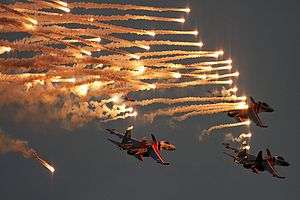
- 9 September 1990: A Soviet Su-27 crashed at the Salgareda airshow in 1990 after pulling a loop at too low an altitude. The Lithuanian pilot, Rimantas Stankevičius, and a spectator were killed.[86][87]
- 12 December 1995: Two Su-27s and an Su-27UB of the Russian Knights flight demonstration team crashed into terrain outside of Cam Ranh, Vietnam, killing 4 team pilots. Six Su-27s and an Ilyushin Il-76 support aircraft were returning from a Malaysian airshow. The aircraft were flying in echelons right and left of the Il-76 on their way to Cam Ranh for refueling. During the landing approach, the Il-76 passed too close to the terrain and the three right-echelon Su-27s crashed. The remaining aircraft landed safely at Cam Ranh. The cause was controlled flight into terrain; contributing factors were pilot error, mountainous terrain and poor weather.[88]
- December 1998: An Ethiopian Air Force Su-27 crashed during a night-flying exercise, resulting in the pilot's death.[89]
- 6 January 1999: An Ethiopian Su-27, piloted by a Russian pilot, crashed while undergoing test flights. The pilot ejected safely.[89]
- 27 July 2002: A Ukrainian Su-27 crashed while performing an aerobatics presentation, killing 77 spectators. Both pilots ejected and suffered only minor injuries.[90]
- 15 September 2005: A Russian Air Force Su-27P crashed in Lithuania after it strayed out of its air corridor while it was flying from St. Petersburg to Russia's Baltic exclave of Kaliningrad due to a mechanical failure. The Su-27 was armed with at least 4 air-to-air missiles. The pilot ejected and was taken into Lithuanian custody. The incident led to an international debate between Lithuania, Russia and NATO.[91][92]
- 29 July 2008: An Su-27UB crashed on a training flight in Primorye Territory, Russia. One pilot was killed, while the other survived.[93]
- 16 August 2009: While practicing for the 2009 MAKS Airshow, two Su-27s of the Russian Knights collided in mid-air above Zhukovsky Airfield, south-east of Moscow, killing the Knights' leader, Igor Tkachenko. One of the jets crashed into a house and started a fire.[94] A probe into the crash was launched; according to the Russian Defense Ministry the accident may have been caused by a "flying skill error".[94][95]
- 30 August 2009: A Belarus Air Force Su-27UBM crashed at the 2009 Radom Air Show in Poland. The Su-27 crashed after exiting a loop, possibly due to an engine failure from a bird strike. Both pilots died after opting to stay with the aircraft to steer it away from the city.[96][97]
- 6 April 2011: A Russian Air Force Su-27SM crashed during a training drill near the city of Vladivostok in Russia's Far East. The pilot ejected unhurt.[98]
- 28 June 2012: A Russian Air Force Su-27UB crashed in Karelia, Russia. Both pilots ejected unhurt.[99]
- 31 March 2013: A Chinese PLA Air Force Su-27UBK crashed during a drill in Shandong, China. Both pilots died.[100]
Aircraft on display
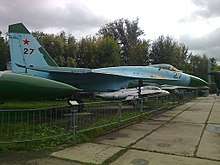
- A Su-27, Red 27 is on display at the Central Armed Forces Museum in Moscow[101][102]
Specifications (Su-27SK)

Data from Gordon and Davison,[103] Sukhoi,[104] KnAAPO,[105] deagel.com,[106] airforce-technology.com[107]
General characteristics
- Crew: 1
- Length: 21.9 m (72 ft)
- Wingspan: 14.7 m (48 ft 3 in)
- Height: 5.92 m (19 ft 6 in)
- Wing area: 62 m² (667 ft²)
- Empty weight: 16,380 kg (36,100 lb)
- Loaded weight: 23,430 kg (51,650 lb) with 56% internal fuel
- Max. takeoff weight: 30,450 kg (67,100 lb)
- Fuel capacity: 9,400 kg (20,724 lb) internal[108]
- Powerplant: 2 × Saturn AL-31F turbofans
- Dry thrust: 75.22 kN (16,910 lbf) each
- Thrust with afterburner: 122.6 kN (27,560 lbf) each
Performance
- Maximum speed:
- Range:
- At altitude: 3,530 km (2,193 mi; 1,906 nmi)
- At sea level: 1,340 km (800 mi; 720 nmi)
- Service ceiling: 19,000 m (62,523 ft)
- Rate of climb: 300 m/s[109] (59,000 ft/min)
- Wing loading:
- With 56% fuel: 377.9 kg/m² (77.3 lb/ft²)
- With full fuel: 444.61 kg/m² (88.01 lb/ft², 91.98 lb/ft² for Flanker SM.)
- Thrust/weight: 1.07 with 56% internal fuel; 0.91 with full fuel
- Maximum g-load: +9 g
Armament
- Guns: 1 × 30 mm Gryazev-Shipunov GSh-30-1 autocannon with 150 rounds
- Hardpoints: 10 external pylons[104][108] with a capacity of up to 4,430 kg (9,770 lb)[104][108] and provisions to carry combinations of:
- Rockets:
- Missiles:
- 6 × R-27R/ER/T/ET/P/EP air-to-air missiles
- 4 × R-73E AAMs
- Bombs:
- RBK-250 cluster bomb
- RBK-500 cluster bomb
- Rockets:
Avionics
See also
Related development
Aircraft of comparable role, configuration and era
Related lists
References
- References
- ↑ Kopp, Dr. Carlo. "Fulcrum and Flanker The New Look in Soviet Air Superiority". AusAirPower.net. First published in Australian Aviation May/June, 1990 by Carlo Kopp. Retrieved 5 March 2015.
- 1 2 Spick, Mike, ed. "MiG-29 'Fulcrum'". "The Flanker". Great Book of Modern Warplanes. Osceola, WI: MBI Publishing, 2000. ISBN 0-7603-0893-4.
- ↑ Niels Hillebrand. "MILAVIA Aircraft - Sukhoi Su-27 Flanker Historical Events & Key Dates".
- ↑ "Prototype of Su-27 and whole Flanker family – T-10 Flanker A". su-27flanker.com.
- ↑ "Prototype of Su-27 and whole Flanker family – T-10 Flanker A". Su-27Flanker.com. Retrieved 5 March 2015.
- ↑ "T-10 Su-27 FLANKER-A Prototype". GlobalSecurity.org. 2000-2015 GlobalSecurity.org. Retrieved 5 March 2015.
- ↑ Kopp, Dr Carlo. "Sukhoi Flankers The Shifting Balance of Regional Air Power Technical Report APA-TR-2007-0101". AusAirpower.net. 2004 - 2014 Carlo Kopp - January, 2007 Updated September, 2009 Updated April, 2012. Retrieved 5 March 2015.
- ↑ "40 Years Ago, 'Streak Eagle' Smashed Records for 'Time to Climb'". UTC.com. 2/18/2015, United Technologies. Retrieved 6 March 2015.
- ↑ "P-42 Record Flanker". ProPro.ru. ProPro Group using materials officially published by Sukhoy design bureau. Retrieved 6 March 2015.
- ↑ Winchester, Jim (2012). Jet fighters : inside & out. New York: Rosen Pub. p. 130. ISBN 1448859824. Retrieved 6 March 2015.
- ↑ "Sukhoi Company (JSC) - Airplanes - Military Aircraft - Su-27SÊ - Historical background". Retrieved 4 February 2015.
- ↑ "Su-27UB FLANKER-C". GlobalSecurity.org. 2000-2015 GlobalSecurity.org. Retrieved 7 March 2015.
- 1 2 Kopp, Dr. Carlo (April 2012). "Sukhoi Su-34 Fullback Russia's New Heavy Strike Fighter Technical Report APA-TR-2007-0108". AusAirpower.net. Retrieved 19 March 2015.
- ↑ Goebel, Greg. "[1.0] First-Generation Su-27s - [1.5] Naval Su-27K (Su-33)". AirVectors.net. v1.4.0 - chapter 1 of 2 - 01 mar 14 - greg goebel - public domain. Retrieved 8 March 2015.
- ↑ Kopp, Dr Carlo. "Sukhoi Su-33 and Su-33UB Flanker D Shenyang J-15 Flanker D Technical Report APA-TR-2008-0603". AusAirPower.net. by Dr Carlo Kopp, AFAIAA, SMIEEE, PEng June, 2008 Updated April, 2012. Retrieved 8 March 2015.
- ↑ "Kuznetsov class Heavy aviation cruiser". Military-Today.com. 2006 - 2015 www.Military-Today.com.
- ↑ "Su-27UBK FLANKER". GlobalSecurity.org. 2000-2015 GlobalSecurity.org. Retrieved 7 March 2015.
- ↑ "Su-27 FLANKER". GlobalSecurity.org. 2000-2015 GlobalSecurity.org. Retrieved 6 March 2015.
- ↑ Kopp, Dr Carlo. "PLA-AF and PLA-N Flanker Variants Technical Report APA-TR-2012-0401". AusAirPower.net. by Dr Carlo Kopp, AFAIAA, SMIEEE, PEng April, 2012 Updated May, 2012. Retrieved 7 March 2015.
- ↑ "Su-27SM [serial modernized]". GlobalSecurity.org. 2000-2015 GlobalSecurity.org. Retrieved 6 March 2015.
- ↑ Katz, Dan. "Program Dossier - Sukhoi Flanker" (PDF). AviationWeek.com. All Program Dossier data is excerpted from the Aviation Week Intelligence Network (awin.aviationweek.com). Retrieved 7 March 2015.
- ↑ "Su-37". FAS.org. Federation of American Scientists. Updated Thursday, March 11, 1999 7:47:49 pm. Retrieved 21 March 2015.
- ↑ "Su-37 Flanker-F Fighter, Russia". Airforce-Technology.com. 2015 Kable, a trading division of Kable Intelligence Limited. Retrieved 21 March 2015.
- ↑ Sukhoi Su-27SK FLANKER-B Archived 29 April 2007 at the Wayback Machine.
- ↑ "Su-27 Historical background". Sukhoi. Retrieved 29 August 2014.
- ↑ "Bear Hunters, Part 3: Collision with Flanker". Retrieved 4 February 2015.
- ↑ "Moscow Defense Brief". cast.ru. Retrieved 1 April 2015.
- ↑ "Georgia and Abkhazia, 1992-1993: the War of Datchas". Retrieved 4 February 2015.
- ↑ Lenta.Ru: Georgian army forces falling back from Tskhinvali (in Russian)
- ↑ Russian airplanes are bombing Georgian army positions Lenta.Ru (in Russian)
- 1 2 Russian fighter jets 'breach Japan airspace', BBC News, 7 Feb 2013
- ↑ Japan accuses Russian jets of violating airspace, DAWN.COM, 7 Feb 2013, retrieved 9 Feb 2013
- ↑ Japan scrambles fighter jets as Russian warplanes intrude into airspace, Kuwait News Agency (KUNA), 7 Feb 2013, retrieved 10 Feb 2013
- ↑ Japan says 2 Russian fighters entered its airspace, Yahoo! News, 7 Feb 2013, retrieved 9 Feb 2013
- ↑ Gertz, Bill (3 June 2014). "Russian jet nearly collides with U.S. surveillance aircraft in 'reckless' intercept in Asia". Washington Free Beacon. Retrieved 3 June 2014.
- ↑ "Sukhoi T-50 PAK FA Stealth Fighter, Russia". Airforce-Technology.com. 2015 Kable, a trading division of Kable Intelligence Limited.
- ↑ "Russian Air Force Carries Out 394 Sorties, Hits 731 Targets in Three Days". Sputniknews. 20 November 2015. Retrieved 28 November 2015.
- 1 2 "Su-27 operations". Milavia.
- 1 2 Claims with No Names, Air Aces page. Archived 11 January 2010 at the Wayback Machine.
- ↑ "Air Aces".
- ↑ "ke bahru be chilfa" (Ethiopian Air Force 2007 graduation publication, May 2007), pp. 72–3
- ↑ Kyzer, Jonathan; Cooper, Tom; Ruud, Frithjof Johan. "Air War between Ethiopia and Eritrea, 1998-2000". Dankalia.com. The acig journal, a Publication of the Air Combat Information Group, Jan 17, 2003, 05:29. Retrieved 10 March 2015.
- ↑ "Moscow Defense Brief".
- ↑ News Desk. "Indonesian Sukhois Arrive at Darwin for Pitch Black 2012". Retrieved 4 February 2015.
- ↑ "Exercise Pitch Black 2012 concludes". Retrieved 4 February 2015.
- ↑ "Russian fighter jets violated Ukraine's air space – ministry". Reuters UK. 3 Mar 2014. Retrieved 4 Mar 2014.
- ↑ "[Photo] Ukrainian Air Force Su-27 Flanker heavily armed for Combat Air Patrol". theaviationist.com.
- ↑ "All flights, including Malaysian B777, were being escorted by Ukrainian Su-27 Flanker jets over Eastern Ukraine". theaviationist.com.
- ↑ "Ukrainian Su-27 Flanker reportedly shot down during special operation against separatists". theaviationist.com.
- ↑ Winchester, Jim (2012). Jet fighters : inside & out. New York: Rosen Pub. p. 128. ISBN 1448859824. Retrieved 6 March 2015.
- ↑ "Su-27 Flanker Variants Overview". Milavia.net
- ↑ Production – Defense – Su-27SKM Archived 13 March 2008 at the Wayback Machine.. KNAAPO
- ↑ "Sukhoi Company has performed the state contract on delivery of new multi-role Su-27SM3 fighters to the Russian air forces". ruaviation.com. Retrieved 1 April 2015.
- ↑
- 1 2 3 4 5 6 "World Military Aircraft Inventory". 2013 Aerospace: Aviation Week and Space Technology, January 2013.
- 1 2 "Су-27 сняты с вооружения в Белоруссии". 7 December 2012. Archived from the original on 19 December 2012. Retrieved 16 December 2012.
- ↑ Niels Hillebrand. "MILAVIA Aircraft - Sukhoi Su-27 Flanker Operators". Retrieved 4 February 2015.
- ↑ "考据的魅力——教你如何识别中国苏-27系列战机". mil.news.sina Source: Sina. Retrieved 5 March 2015.
- ↑ Wei, Bai (May 2012). "A Flanker by any other name". Air Forces Monthly (290): 72–77.
- ↑ "考据的魅力——教你如何识别中国苏-27系列战机". mil.news.sina Source: Sina. Retrieved 5 March 2015.
- ↑ Rupprecht, Andreas (December 2011). "China's 'Flanker' gains momentum. Shenyang J-11 update". Combat Aircraft Monthly. 12 (12): 40–42.
- ↑ . Asiarussia.ru
- ↑ . Asiarussia.ru
- 1 2 "World Military Aircraft Inventory". 2014 Aerospace: Aviation Week and Space Technology, January 2014.
- ↑ "Су-27 предлагают списать". samara-airlines.ru. Retrieved 1 April 2015.
- ↑ "Lenta.ru: Наука и техника: ВВС России получат восемь новых истребителей Су-27СМ". Retrieved 4 February 2015.
- ↑ AirForces Monthly, Dec 2010
- ↑ "ÖÀÌÒÎ / Íîâîñòè / Àâèàïàðê Ñó-27 ÂÂÑ ÐÔ ìîäåðíèçèðîâàí áîëåå ÷åì íà 50%, äî êîíöà ãîäà îæèäàåòñÿ ïîñòóïëåíèå ïåðâûõ øåñòè ñåðèéíûõ Ñó-35". 13 March 2012. Retrieved 4 February 2015.
- ↑ "Летчики ЮВО получат более 40 единиц авиатехники - Еженедельник "Военно-промышленный курьер"". Retrieved 4 February 2015.
- ↑ "Су-27 - Український мілітарний портал - Український мілітарний портал". Archived from the original on January 18, 2012. Retrieved February 27, 2014.
- ↑ "Ukraine loses half of its military aircrafts [sic] in one year of Donbas war" (Weekly). Mirror Weekly Ukraine. International. January 27, 2015. Retrieved 27 March 2015.
- ↑ "World Air Forces 2018". Flightglobal Insight. 2018. Retrieved 4 May 2018.
- 1 2 Niels Hillebrand (11 October 2008). "Su-27 Flanker Operators List". MILAVIA. Retrieved 12 October 2008.
- ↑ Gordon and Davison 2006, p. 101.
- ↑ U.S. buys Su-27 fighters from Ukraine for 'aggressor' training. RIA Novosti
- ↑ "Directory: World Air Forces". Flight International, 14–20 December 2010.
- ↑ "Су-27 сняты с вооружения в Белоруссии". Archived from the original on 19 December 2012.
- ↑ "Belarus to modernize its fleet of Sukhoi Su-27 jet fighter". January 31, 2014.
- ↑ John Pike. "Fighter Aviation (Istrebitel'naya Aviatsiya) / Samolet Istrebitel Perehvatchik Aircraft Fighter Interceptor". Retrieved 4 February 2015.
- ↑ "FAA Registry - Aircraft - Make / Model Inquiry". faa.gov. Retrieved 1 April 2015.
- ↑ "Pride Aircraft: Sukhoi SU-27 Flankers".
- ↑ "Cold war base to be private 'Top Gun' school". Financial Times. Retrieved 4 February 2015.
- ↑ Air International October 2010, p. 9.
- ↑ "NATO 'no comment' on Russian warplane deal report". 1 September 2010. Retrieved 4 February 2015.
- ↑ "Belarus to upgrade its Su-27 fighters". Retrieved 4 February 2015.
- ↑ "Salgareda airshow crash 1990".
- ↑ 9 September 1990 crash of Su-27. aviation-safety.net, 11 January 2011.
- ↑ Sidorov, Pavel. "Катастрофа "Русских Витязей" (in Russian)". RU.AVIATION по материалам «ВЕСТHИК ВОЗДУШHОГО ФЛОТА 1-2 1996 года». Retrieved 2007-04-24.
- 1 2 "Central, Eastern, & Southern Africa Database" Archived 1 February 2010 at the Wayback Machine.
- ↑ "Pilots blamed for air show crash". CNN. 7 August 2002.
- ↑ Niels Hillebrand. "MILAVIA Aircraft – Sukhoi Su-27 Flanker Historical Events & Key Dates". Milavia.net. Retrieved 2011-08-30.
- ↑ "Europe | Russian jet jangles Baltic nerves". BBC News. 2005-09-20. Retrieved 2011-08-30.
- ↑ "Su-27 Flanker fighter crashes in Russia's Far East, 1 pilot dead". RIA Novosti. 29 July 2008.
- 1 2 "Pilot dies as Russia jets collide". BBC News. 17 August 2009. Retrieved 24 May 2010.
- ↑ "Pilot killed as two Su-27 fighters collide southeast of Moscow". RIA Novosti. 16 August 2009.
- ↑ "Belarusian Air Force Sukhoi Su-27 crash". Centrum Prasowe AIR SHOW – 2009. 30 August 2009. Archived from the original on 4 March 2010.
- ↑ "Belorussian jet crashes at Polish airshow". Archived from the original on 5 September 2009.
- ↑ Harro Ranter. "ASN Aircraft accident 06-APR-2011 Su-27SM Flanker 08 blue". aviation-safety.net. Retrieved 1 April 2015.
- ↑ Sputnik (28 June 2012). "Su-27 Fighter Jet Crashes in Karelia".
- ↑ "PLA Fighter Jet Crash: Two Die In Chinese Military Air Drill [VIDEO]". International Business Times. 2 April 2013. Retrieved 4 February 2015.
- ↑ "Armed Forces Central Museum - Military historical Tour in Central Museum of Armed Forces". Retrieved 4 February 2015.
- ↑ "Scramble Messageboard • View topic - The Central armed forces museum Moskva 10-08-2012". Retrieved 4 February 2015.
- ↑ Gordon and Davison 2006, pp. 91–92, 95–96.
- 1 2 3 Su-27SK Aircraft performance page Archived 16 July 2011 at the Wayback Machine.. Sukhoi.
- 1 2 Sukhoi Su-27SKM. KNAAPO.
- ↑ Su-27. Deagel.com
- ↑ Su-27. Airforce technology
- 1 2 3 "Sukhoi Company (JSC) - Airplanes - Military Aircraft - Su-27SÊ - Aircraft performance". Archived from the original on 16 July 2011. Retrieved 4 February 2015.
- ↑ "Sukhoi Su-27 Flanker". fighter-planes.com. Retrieved 1 April 2015.
- Bibliography
- "ECA Program Su-27 Flankers Destined for Iceland". Air International. October 2010, Vol. 79 No. 4. p. 9. ISSN 0306-5634.
- Gordon, Yefim. Sukhoi Su-27 Flanker: Air Superiority Fighter. Airlife Publishing, 1999. ISBN 1-84037-029-7.
- Gordon, Yefim and Peter Davison. Sukhoi Su-27 Flanker, Specialty Press, 2006. ISBN 978-1-58007-091-1.
- Modern Combat Aircraft: Reference guide, pp. 50–51. Minsk, "Elida", 1997. ISBN 985-6163-10-2. (in Russian)
- North, David M. Su-27 pilot report - part 1 Part 2
External links
| Wikimedia Commons has media related to Sukhoi Su-27. |
- Su-27SК Sukhoi
- Su-27 page on knaapo.ru
- ECA Program BV Website
- Su-27SК Russia Military Analysis
- Su-27 page GlobalSecurity.org
- Sukhoi Flankers – The Shifting Balance of Regional Air Power
- Asia's Advanced Flankers
- The Su-27SKM
- Su-27 free walkaround (37 shots)
- Su-27UB walkaround photos